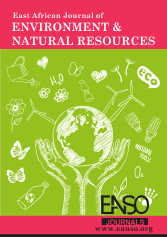Environmental Impacts of Household Solar Energy Use Adoption in Murang’a County, Kenya
Ikisiri
Although Kenya enjoys an abundant of sunshine throughout the year, most households in counties like Murang’a still use non-renewable sources of energy for their energy needs. Globally, households account for approximately 40% of energy consumption per annum with most needs being heating, air conditioning, cooling and lighting. Environmental management is now a global goal with over 197 nations endorsing a framework that promotes positive environmental impact through renewable energy and reduced C02 emissions during COP21 in Paris. This research mainly focused on positive environmental impacts of solar energy use adoption within households in Murang’a County, Kenya. Guided by the transition theory, the research applied anticipated transitions to discuss different aspects of solar energy use adoption in the county and the impact they have on the environment. This qualitative and quantitative study sought to explore perspectives of various households on solar energy use and how the adoption has positively impacted the environment. The data used for the study was collected from 384 randomly selected households in four constituencies in Murang’a County. The findings of the study established low adoption rates of households’ solar energy use and a direct correlation of adoption levels with the awareness levels for most of the study population. Moreover, the study confirmed the hypothesis that solar energy use adoption in households positively influenced environment through management strategies and improved livelihoods. Furthermore, policy measures to support training as well as financial support would go a long way in increasing uptake of solar energy use in households in Murang’a County thus positively influencing the environment through management strategies such as renewable energy use
Upakuaji
Marejeleo
Abdeen, M. O. (2009). Energy use and environmental impacts: A general review. Renewable Sustainable Energy 1, 053101 (2009); https://doi.org/10.1063/1.3220701.
AGECC, U. (2010). The secretary-general’s advisory group on energy and climate change (AGECC)
Energy for a sustainable future report and recommendations. New York, April, 28, 2010.
Anker-Nilssen, P. (2003). Household energy use and the environment—a conflicting issue. Applied Energy. Elsevier
Barnes, D.F. (2007). The Challenge of Rural Electrification: Strategies for Developing Countries. ESMA and RFF (UNDP/World Bank Energy Sector Management Assistance Program and Resources for the Future).
Bostley M. A., Peter A. I. (2023). Scientific Research Sample Size Determination. The International Journal of Science & Technology.
Cox, S. (2016). Financial incentives to enable clean energy deployment: Policy overview and good practices (No. NREL/TP-6A20-65541). National Renewable Energy Lab. (NREL), Golden, CO (United States).
Fares R., Webber, M. (2017). The impacts of storing solar energy in the home to reduce reliance on the utility. Nat Energy 2, 17001 (2017). https://doi.org/10.1038/nenergy.2017.1.
Gitone, I. S. A. A. C. (2014). Determinants of adoption of renewable energy in Kenya (Doctoral dissertation, University of Nairobi).
Hamed, T. A., Alshare, A. (2022). Environmental Impact of Solar and Wind energy- A Review, J. sustain. Dev. energy water environ. syst., 10(2), 1090387, 2022, DOI: https://doi.org/10.13044/j.sdewes.d9.0387.
IRENA. (2019). Climate Change and Renewable Energy: National policies and the role of communities cities and regions (Report to the G20 Climate Sustainability Working Group (CSWG)), International Renewable Energy Agency, Abu Dhabi.
Jonathan A. O., Owoicho, C., Dahiru, K. M. (2018). Environmental Issues and Food Insecurity in Africa. Department of Geography, Benue State University, Nigeria Submission: June 11, 2018; Published: July 05, 2018.
Kaile, Z., Shanlin, Y. (2016). Understanding household energy consumption behavior: The contribution of energy big data analytics. Renewable and Sustainable Energy Reviews. Elsevier
Kaygusuz, K. (2009). Environmental Impacts of the Solar Energy Systems. Online publication: 16 June 2009.
Kenneth, E. O., Ahmed, T., Abdel, G. A. (2020). Wind Solar Hybrid Renewable Energy Systems. Bod Books on Demand (Publisher)-2020.
Linda, S. (2008). Promoting household energy conservation. Publication on Energy Policy. Elsevier.
Mohammad, A., Nisreen L. (2019). Solar energy farming as a development innovation for vulnerable basins, Development in Practice, 29:5, 619- 634, DOI: 10.1080/09614524.2019.1600659.
UN. (2020). Pathways to Sustainable Energy - Accelerating Energy Transition in the UNECE Region; ECE Energy Series No. 67. United Nations Geneva.
UNDP, A. (2012). Africa Human Development Report 2012 Towards a Food Secure Future (No. 267636). United Nations Development Programme (UNDP).
US-EPA. (2011). Shining Light on a Bright Opportunity: developing solar energy on abandoned mine lands OSRTI Abandoned Minelands. Team December 2011, United Stated Environmental Pollution Agency (EPA).
Williams, J. H., DeBenedictis, A., Ghanadan, R., Mahone, A., Moore, J., Morrow III, W. R., & Torn, M. S. (2012). The technology path to deep greenhouse gas emissions cuts by 2050: the pivotal role of electricity. Science, 335(6064), 53-59.
Ying Z., Muttucumaru, S. S. Y., Keith E., Mohammad R. (2018). Application of solar energy in water treatment processes: A review, Desalination, Volume 428, 2018, Pages 116-145.Bostley Muyembe Asenahabi, Peters Anselemo Ikoha. (2023). Scientific Research Sample Size Determination. The International Journal of Science & Technology.
Copyright (c) 2024 Pauline N. Mutura, Peter Kamau, PhD, Christine Majale, PhD

This work is licensed under a Creative Commons Attribution 4.0 International License.




























